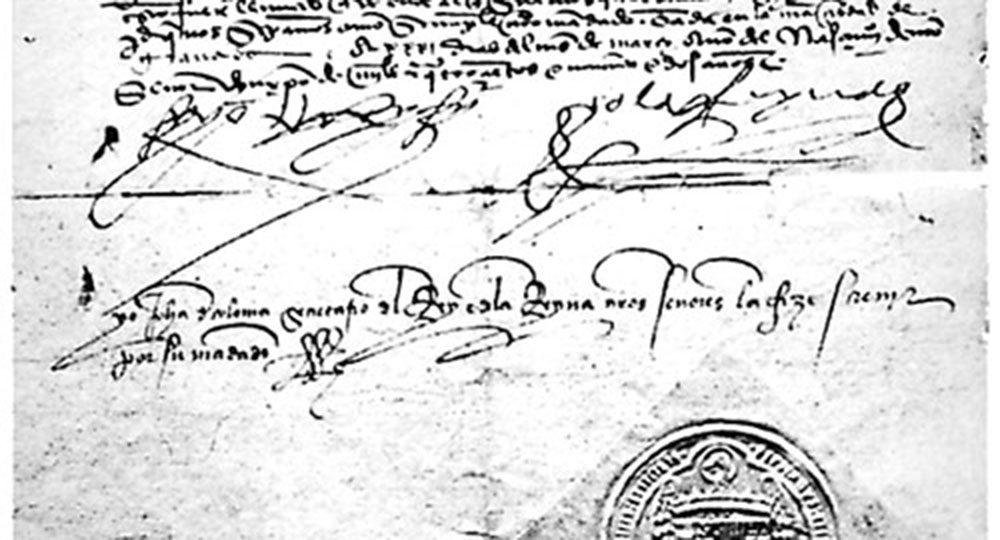The Madness and Tragedy of 1492
No single event in the history of Medieval Europe stirs the imagination more than the expulsion of Spanish Jewry in 1492. It was the most infamous of all expulsions, striking an entire population of hundreds of thousands at the same time throughout the country.
The cause of this catastrophe can be traced to a combination of three forces. Like rising pressure in a volcano, these forces seethed, merged, and eventually exploded, resulting in what can only be described as the madness and tragedy of 1492.
The Renewed Spanish Nationalism 1492
The eighth century saw Spain conquered by the crescent armies of Islam. Fortunately for Europe, the Islamic expansion was stopped by the Frankish General Charles Martel in 732 A.D. In the centuries that followed, the people of Spain sought to recapture their country. It was a long savage struggle resulting in Jews, along with Muslims, being slaughtered by the thousands.
Throughout this tumultuous period, the church and the civil government were in constant conflict. The issue was unconverted Spanish Jews. In spite of the continuous and relentless pressure to bring reluctant Jews to the baptismal font, most of the Jewish people of Spain rejected conversion, thus placing them outside of church control. Frustrated, the church in Spain advocated, as early as the 14th century, expulsion of its Jews.
The state, desiring to thwart the ambitions of the church, resisted the expulsion option since the civil authorities needed the Jewish people to help run the country. Because of widespread corruption, the nobles, the rich, and especially the clergy could not be trusted. It was felt that the Jews were far safer to use in administrative positions, inasmuch as they were, for the most part, outside of the intrigues of court politics. As a whole, the Jewish people were highly skilled and were sought after by merchants to run their businesses. Perhaps the civil government was so friendly toward the Jewish people because they strengthened the coffers of the petty kingdoms by paying directly into the royal treasuries. Resented by the nobility because of their privileged positions and envied by a covetous religious system, the Jews became a convenient scapegoat for all of the country’s political and financial problems.
The recapture of the southern province of Granada from the Moors brought Spain again under complete church sovereignty. With church bells ringing and the joyful shouts of the people, a renewed nationalism spread throughout the land. Sermons and speeches praising the unification of Spain for true Spaniards also brought denouncement of the Jews as foreigners. Some falsely accused them of collaborating with the Moors. This volatile atmosphere was exploited by the merchants and various artisans to slander the Jews as unscrupulous competitors. Hostilities intensified, and the Jews were on the road to disaster.
The Creed of Church and State
Everyone needed money. The war with the Mohammedans in the south put a financial strain on the treasuries. A new source of revenue was urgently needed, but the question was where to get the money.
It soon became standard procedure from time to time for monks, followed by riotous mobs, to go from town to town and city to city, invading Jewish neighborhoods. They offered the Jews a choice: baptism or death. Many chose death. Others, especially among the upper classes, accepted baptism as a convenience. These new conversos were expected to follow the observances of the church. To revert back to the practice of Judaism was considered heresy. Within time, many of these conversos rose high on the ecclesiastic and economic scales. Motivated by jealousy and suspicion, a movement arose within the church that questioned the sincerity of the conversos’ faith. A call for an inquisition was soon advocated. The primary function of this movement was to root out and punish heresy. If an individual was found guilty, the church was entitled to confiscate all of his property. However, for the state this meant taxable revenue lost from its royal treasury. Therefore, the church at first received very little support in their inquisition from the civil government.
But the government’s attitude toward the inquisition soon changed when an unfortunate incident occurred. Some conversos were caught hosting a Passover Seder. This “heretical” deed sent revulsions throughout the church. Even King Ferdinand and Queen Isabella felt scandalized. A full-fledged inquisition of all Jewish converts was demanded. Yet the matter of confiscations had to be settled. It was finally agreed that all charges of heresy would also be considered acts of treason against the state. Now the church and state could each have a share of the booty.
Denouncing rich conversos proved to be very lucrative. When the supply of living conversos was exhausted, the dead were exploited. Bodies were exhumed, and the decayed remains of the suspect were lashed erect to a stool. A full-scale, formal trial was then conducted. The victim, not “willing” to answer to the charges, was naturally found guilty. The penalty was the confiscation of the entire estate of the deceased. Many of the families of those upper-class Jews who converted out of convenience lost their livelihood. As long as conversos (alive or dead) were plentiful, the church and state could count on an ample supply of revenue to enrich their treasuries.
The Cross Becomes a Sword
Not all church members were interested in material gain. Some zealously advocated and contended for the spiritual purity of the church. By the late 15th century the church increased its dominance over the state. Acting independently with disregard for civil law, monks brandished their crosses like swords, crying, “Baptism or death!” By the thousands, Jewish people were slaughtered. All conversos were contemptuously referred to as Marranos (swine). In the estimation of the church, something drastic had to be done because the “heretical tendencies” among the Marranos were growing at an alarming rate. They believed that the problem was the unconverted Jews.
In desperation, the church appointed the ruthless Tomas de Torquemada to be Inquisitor General He was single-handedly responsible for 2,000 auto-da-fe’ (acts of faith), which were public burnings of victims, and the imprisonment of about 100,000 people.
Frustrated that Marranos could not remain “pure,” Torquemada concluded that the Jewish influence had to be removed. He persuaded King Ferdinand and Queen Isabella that the immediate expulsion of the Jews from Spain was urgently needed for the glory of the church. And so, on March 30, 1492, the infamous Edict of Expulsion was signed.
Soon after, a distinguished delegation from the Jewish community came before the king and queen to plead against the edict. Knowing how the royalty loved money, the leaders offered to pay a huge sum to the royal treasury from their personal accounts. The rulers began to waiver, and tradition has it that at that very moment, Torquemada burst into the royal chamber. With eyes ablaze in anger and waving a crucifix, he cried, “Behold the Savior, whom the wicked Judas sold for thirty pieces of silver! If you approve of that deed, then sell Him for a great sum.” Stunned by this reproof, the royalty rejected the delegation’s plea. The edict remained in force.
The Edict of Expulsion required that all Jews throughout the kingdom were to leave by the first of August. They were forced to sell their homes, lands, and cattle at ridiculously low prices. The edict also forbade them to carry out silver or gold, so they were forced to exchange their precious metals for cheap merchandise of cloth, skins, and other worthless items.
This sudden source of revenue meant that Ferdinand and Isabella could finance exploration, which seemed to be the latest fad around that period. Just before the edict was signed, a frustrated mapmaker from Genoa—Cristobal Colón (Christopher Columbus)—had come seeking financial aid for his own expedition. He got it, thanks largely to the Jews of Spain!
It is estimated that about 300,000 people were expelled. Untold horror stories of shipwrecks, piracy, starvation, and enslavement became part of the Jewish experience. Gone was the only glory that the remnant of the Hebrew nation had known since the destruction of the Second Temple.
The expulsion of 1492 resulted in tragedy for everyone. First, it was a tragedy for Spain, for never has this country risen to the glory it once knew. God judged Spain against the principle, “I will bless them that bless thee [Abraham’s physical descendants], and curse him that curseth thee” (Gen. 12:3). Second, it was a tragedy for the Jewish people. This bitter experience has left an indelible impression on the Jewish psyche that outside of Israel they will always be “an alien in a foreign land” (Ex. 2:22b). Finally, and most tragic, is what Spain did to the cause and testimony of Jesus Christ. The church and state used the Lord and His name for their own personal gain. Each auto-da-fe’ witnessed the burning of the teachings of Christ. Each illegal confiscation witnessed the robbery of the cause of Christ. And the ruthless eviction of the Jewish people from Spain’s shores was a witness to the disowning of the person of Jesus Christ.
Although the year 1492 commemorates the epic voyage of Christopher Columbus, it should also remind us of the calamitous event that befell the Jewish people of Spain. Lest it be forgotten, two biblical principles that were snubbed in the madness of 1492 are still crying out to be heard and practiced today.
Let love be without hypocrisy. Abhor that which is evil; cling to that which is good (Rom. 12:9).
Love worketh no ill to its neighbor; therefore, love is the fulfilling of the law (Rom. 13:10).








